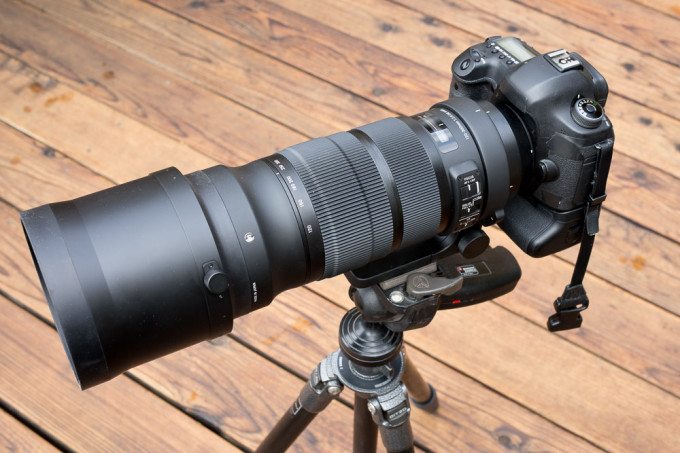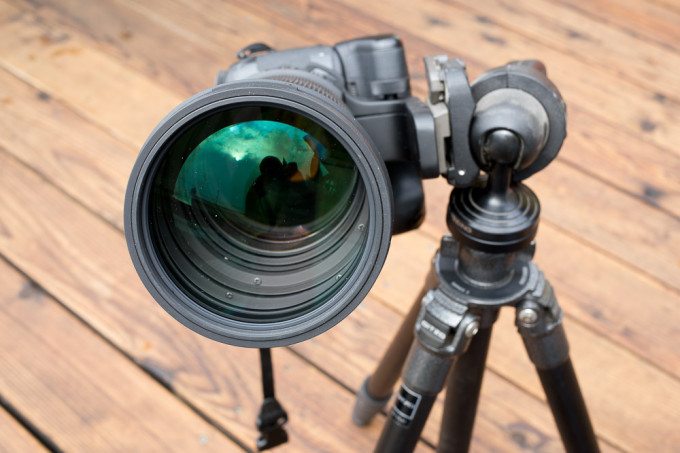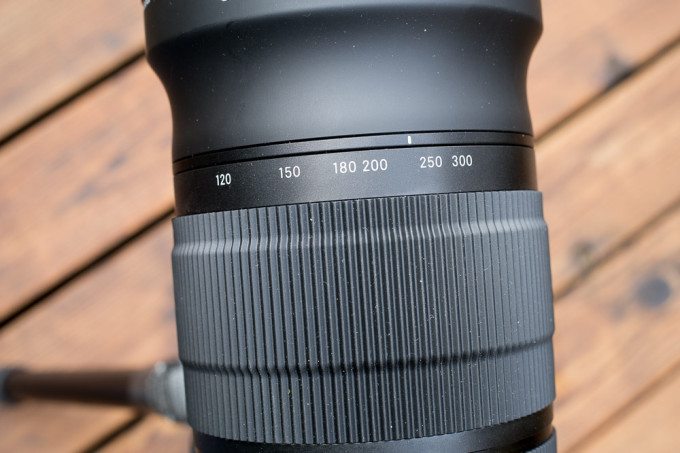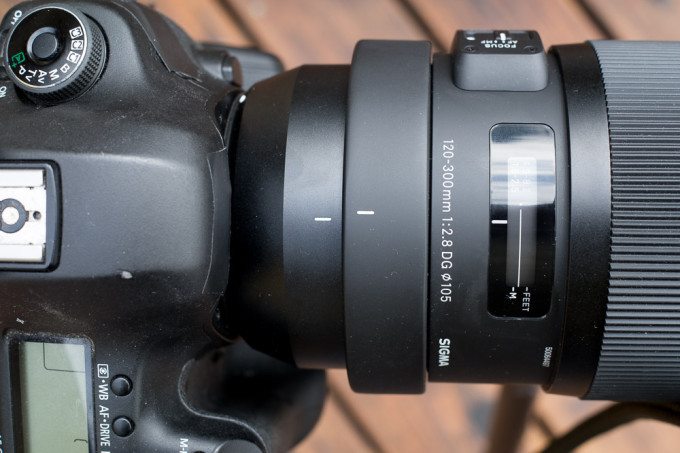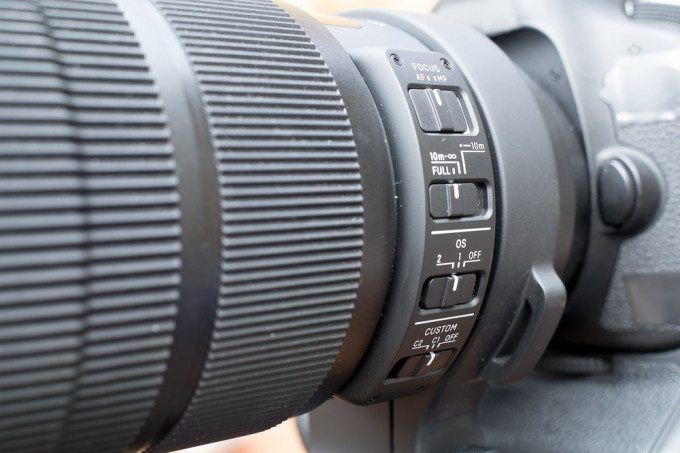Telephoto zooms have often been compared unfavorably to their fixed focal lengths equivalents. They are usually slower lenses not only in terms of their maximum aperture, but also their focusing speed. Though they are often more affordable and weigh less than a fast fixed telephoto, the compromise in image quality is something many assume that they sacrifice if they can’t afford investing in a more expensive, faster aperture lens. That’s not always the case, but it nevertheless leaves many pining for a fast-aperture fixed lens.
The Sigma 120-300 f/2.8 DG OS HSM IS intends to eliminate such stigma by providing a fast telephoto zoom with an f2.8 maximum aperture, that promises exceptional image quality and all for an affordable price. Let’s see how it delivers.
Pros & Cons
Pros
- Fast maximum aperture of f2.8
- Excellent build quality with ribbed zoom and focusing rings.
- Minimal pin cushioning and vignetting, easily correctible in Photoshop or Lightroom
- Sigma USB Dock and Sigma Optimization Pro software allows users to update firmware as well as customize lens autofocus performance
- HSM design provides for speed and relatively quiet autofocus
Cons
- No drop-in filter, requiring the purchase of relatively large front-end filters.
- While hand-hold-able, the weight may be too much for some photographers.
- Lack of exposure or focus lock button on barrel. (Not a deal breaker but it would have been nice)
Gear Used
For this review, I used the lens with the Canon EOS 5D Mark III, a Gitzo GT2541 tripod with a Manfrotto 33RC2 pistol grip head. A Sandisk Extreme 32GB card and an Upstrap Large Pad Camera Strap. The lens was carried in a Niko Messenger Bag.
For those of you, who like to read the tech specs, look below. If you don’t like reading tech specs scroll further down for my review and sample images.
Technical Specs
Specs taken from the Sigma website.
| Lens Construction | 24 Elements in 18 Groups | |
| Angle of View | 20.4º-8.2º | |
| # of Diaphragm Blades | 9 | |
| Minimum Aperture | f22 | |
| Minimum Focusing Distance | 150cm -250cm cm / 59.1in – 98.4in | |
| Filter Size (mm) | 105mm | |
| Maximum Magnifications | 1:8.1 | |
| Minimum Focusing Distance | 150cm -250cm cm / 59.1in – 98.4in | |
| Dimensions | 124.4mm x 291mm/4.8in x 11.5in | |
| Weight | 790g / 27.9oz. |
HSM – Hyper-Sonic Motor
OS – Optical Stabilization
IF – Inner Focus
DG – DG for Digital
Ergonomics
The large front element of the lens provide excellent light gathering capability and results in a 105mm filter thread. It’s a massive beast and you’ll be best off keeping the lens hood on to protect it.
The ribbed rubber zoom ring is located closest to the front element and allows for an easy grip. The short throw from 120mm to 300mm allows photographers to quickly move through the entire focal length range of the lens.
The lens features a rubbered, ribbed focusing ring which offers good a feeling of resistance when focusing manually. The lens also includes a removable lens collar. A distance scale measuring distances in both meters and feet is located right behind the focus ring.
The lens has four switches for controlling performance. The first control switches the lens between autofocus and manual focus. This is followed by a focus limiter switch to constrain what distances the lens will search for focus. It next offers 2 types of optical stabilization as well as an off mode. The last switch provides access to the custom functions which can be set using the supplied USB Dock and Sigma Optimization Pro software.
Build Quality
Once I held the lens in my hands, there was little doubt about its solid construction. With a weight of 27.9 ounces, the lens has some heft to it, but it can be used reasonably hand-held, though I would recommend using it on a tripod or monopod whenever possible. The body of the lens includes metal construction with ribbed, rubber rings for the zoom and focusing rings. The slider switches that control the focus mode, focus limiter, optimal stabilization and the custom modes have positive click stops. The removable collar includes a foot with three ¼-20 holes for attaching to a tripod or monopod. The finish is a dull matte that provides a nice clean and pro look to the lens.
A metal lens hood comes with the lens, providing protection against flare. It’s has a textured knob to help secure the hood in place. However, you will likely forgo the use of the hood if you are using a polarizer as there is no drop-in filter and you would instead need to attach a 105mm filter to the front of the lens.
Autofocusing
The focusing speed on the 120-300mm lens was excellent when used with the Canon 5D Mark III. I was shooting with the lens on several overcast days, which reduced the quantity of light that I had to work with, but that didn’t hamper the autofocus performance in any way. The Hyper-Sonic Motor provided fast and quiet autofocus, which allowed me to focus more on my composition rather than worrying about the camera’s ability to accurately and quickly detect focus.
Because I was often shooting at fairly wide apertures with a limited depth of field, I chose a single AF sensor for focus detection. This helped ensure that the most important part of my subject was tack sharp. Though I have the option to fine-tune the focus performance using the included Sigma USB dock and Sigma Optimization Pro software, I got sharp results straight out of the box.
Because depth of field is so slim at f/2.8, it’s important to nail the focus. This is why I highly recommend choosing a single AF sensor point for focus detection. Otherwise, the camera can detect another area of the subject for focus, which can lead someone to believe that their lens is suffering from a front-focus or back-focus issue, rather than being simply being bad focusing technique.
Ease of Use
For those not accustomed to using such long focal lengths, there will be a short learning curve to effectively handle the lens both hand-held and on a tripod. For all other users, it should prove a seamless transition.
Image Quality
The overall performance of the lens was excellent. Since, it reasonable to expect that the lens will most often be used at its moderate to widest aperture, my evaluation of the lens largely fell within this f-stop range and the optics consistently delivered with respect to sharpness. Contrast was good, delivering good details throughout the shadows and the highlights, but still delivering a nice snap to the photographs. Fine-details were rendered especially well even at moderate apertures of f4 and f5.6.
Sharpness
At the point of focus, the lens delivered consistently sharp results. Though there might have some slight drop of sharpness towards the edges on occasion, it wasn’t an issue for me because of the types of subjects that I was photographing. If we were in the profession of shooting brick walls, I might have something to be concerned with for real-world photography I was not disappointed.
Color Rendition
All color were rendered very nicely. Even high saturated colors such as red, which can be made to appear over saturated with some lenses, appeared clean and neutral.
Bokeh
The bokeh or quality of the out focus areas of the photographs were completely acceptable to me. Though it lacks the kind of “creamy” bokeh that many photographers are eager to see, I did not feel that the images suffered in anyway because it falls short of that mark.
Color Fringing
With high contrast subject matter, I was hard pressed to find any evidence of color fringing.
Extra Image Samples
Conclusions
Despite my initial trepidation about using the Sigma 120-300mm f2.8 DG OS HSM IS lens, I have to admit I quickly got accustomed to it. Most importantly, I was very happy with its optical quality. Using a telephoto zoom like this called on me to shoot differently than I do when I using my usual normal and wide focal lengths. Learning how to use it effectively on a tripod as well as hand-held took a little bit of doing, but once I became more comfortable with this, I was able to use the lens as seamlessly as I do any of my other lenses.
With a relative street price of $3599, this is an ideal lens for sports and nature photographers. The focal length range combined with the fast maximum aperture will help to provide good performance even under low light conditions. Though the overcast days didn’t provide me with a great quality of light, it did allow me to see how the lens would perform especially with subjects with relatively low contrast. It delivered consistently, eliminating the need for me to switch over to manual focus.
If I were to recommend anything for this lens, it would be the additional purchase of a Sigma 1.4X EX APO DG teleconverter. Though the 300mm focal length is ample for a lot of photography, I found myself often desiring just a little more magnification. And with the lens offering such a wide aperture to begin with, the loss of 1 stop of light ensures that the lens will still perform ably even under lower light conditions.
Please Support The Phoblographer
We love to bring you guys the latest and greatest news and gear related stuff. However, we can’t keep doing that unless we have your continued support. If you would like to purchase any of the items mentioned, please do so by clicking our links first and then purchasing the items as we then get a small portion of the sale to help run the website.


